senses
Introduction
also called sensory reception or sense perception
 means by which animals (animal) detect and respond to stimuli in their internal and external environments. The senses of animals are most usefully described in terms of the kind of physical energy, or modality, involved. There are four main modalities: the light senses ( photoreception; i.e., vision), the mechanical senses ( mechanoreception; i.e., touch, balance, and hearing), the chemical senses ( chemoreception; i.e., taste and smell), and the electric sense (electroreception) of certain fish. In addition to these external senses there are also internal senses that use the same modalities. For example, there are proprioceptors, which are mechanical sensors that measure the lengths of muscles (muscle) and positions of joints (joint), and there are interoceptors that monitor blood pressure. Similarly, there are chemoreceptors that monitor blood CO2 ( carbon dioxide) and pH levels, as well as a variety of receptors (receptor) that respond at the cellular level to the presence of hormones (hormone) and metabolites.
means by which animals (animal) detect and respond to stimuli in their internal and external environments. The senses of animals are most usefully described in terms of the kind of physical energy, or modality, involved. There are four main modalities: the light senses ( photoreception; i.e., vision), the mechanical senses ( mechanoreception; i.e., touch, balance, and hearing), the chemical senses ( chemoreception; i.e., taste and smell), and the electric sense (electroreception) of certain fish. In addition to these external senses there are also internal senses that use the same modalities. For example, there are proprioceptors, which are mechanical sensors that measure the lengths of muscles (muscle) and positions of joints (joint), and there are interoceptors that monitor blood pressure. Similarly, there are chemoreceptors that monitor blood CO2 ( carbon dioxide) and pH levels, as well as a variety of receptors (receptor) that respond at the cellular level to the presence of hormones (hormone) and metabolites.Light senses
 vision is used by animals to determine the layout of their surroundings, and thus this sense is particularly important for locomotion. In animals with eyes (eye, human) that have good resolution, vision can be used to identify objects from their geometric appearance; however, this requires a sophisticated brain of the kind found in vertebrates (vertebrate), cephalopod mollusks such as octopus, and higher arthropods (arthropod), such as bees (bee) and jumping spiders (jumping spider). All vision, or photoreception, relies on photoreceptors that contain a special light-detecting molecule known as rhodopsin. Rhodopsin detects electromagnetic radiation—light with wavelengths (wavelength) in the range 400–700 nanometres (1 nm = 10−9m). There are some animals that can detect infrared radiation (wavelengths greater than 700 nm); for example, some snakes (snake) use infrared radiation to locate warm-blooded (warm-bloodedness) prey, and certain beetles (beetle) can use it to sense forest fires (forest fire). However, animals that detect wavelengths in the infrared do this with receptors that sense heat or mechanical expansion, rather than with photoreceptors.
vision is used by animals to determine the layout of their surroundings, and thus this sense is particularly important for locomotion. In animals with eyes (eye, human) that have good resolution, vision can be used to identify objects from their geometric appearance; however, this requires a sophisticated brain of the kind found in vertebrates (vertebrate), cephalopod mollusks such as octopus, and higher arthropods (arthropod), such as bees (bee) and jumping spiders (jumping spider). All vision, or photoreception, relies on photoreceptors that contain a special light-detecting molecule known as rhodopsin. Rhodopsin detects electromagnetic radiation—light with wavelengths (wavelength) in the range 400–700 nanometres (1 nm = 10−9m). There are some animals that can detect infrared radiation (wavelengths greater than 700 nm); for example, some snakes (snake) use infrared radiation to locate warm-blooded (warm-bloodedness) prey, and certain beetles (beetle) can use it to sense forest fires (forest fire). However, animals that detect wavelengths in the infrared do this with receptors that sense heat or mechanical expansion, rather than with photoreceptors.The rhodopsin molecule of photoreceptors consists of a protein called opsin that straddles the cell membrane (cell) with seven helices. These form a structure with a central cavity that contains a chromophore group, which in humans is called retinal—the aldehyde of vitamin A. When retinal absorbs a photon of light, it changes its configuration (from the bent 11-cis form to the straight all-trans form), setting off a series of molecular reactions that lead, within a few milliseconds, to a change in the flow of ions (ion) through the cell membrane. In vertebrates light causes the closure of sodium channels, whereas in most invertebrates (invertebrate) light results in the opening of sodium channels. One of the functions of the opsin molecule is to “tune” the chromophore group to respond to a particular range of wavelengths. Thus, different opsins with different amino acid sequences allow an organism to have receptors with different spectral responses; this is the basis of colour vision. In humans the rods (rod), which are used for night vision and are sensitive to single photons, are maximally sensitive to blue-green light (496 nm), and the three classes of cones, which mediate colour vision in daylight, are maximally sensitive to blue (419 nm), green (531 nm), and red (558 nm) light. In bees (bee), which also have colour vision, the three maxima are shifted toward shorter wavelengths—ultraviolet (344 nm), blue (436 nm), and green (556 nm). Ultraviolet receptors are also found in birds (bird) and fish.
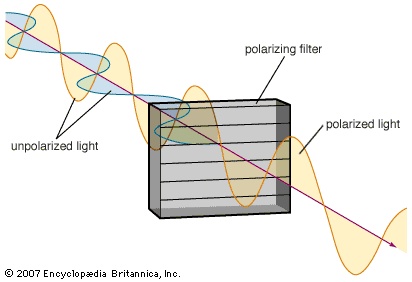 Many invertebrates have the capacity to see and analyze polarized light. polarization arises from atmospheric scattering and reflection at smooth surfaces such as water. In polarized light all the photons have their electrical fields vibrating in the same plane; this can be detected by photoreceptors if the molecules are appropriately aligned. The projecting microvillus structure of invertebrate receptors makes this possible. Many insects (insect) use polarization to work out the Sun's direction when the sky is overcast, and others use it to detect water surfaces.
Many invertebrates have the capacity to see and analyze polarized light. polarization arises from atmospheric scattering and reflection at smooth surfaces such as water. In polarized light all the photons have their electrical fields vibrating in the same plane; this can be detected by photoreceptors if the molecules are appropriately aligned. The projecting microvillus structure of invertebrate receptors makes this possible. Many insects (insect) use polarization to work out the Sun's direction when the sky is overcast, and others use it to detect water surfaces.The optical systems of eyes break down light according to its direction of origin and thus form images that can be used for navigation and pattern recognition. There are about 10 ways of forming images, including pinholes, lenses (lens), and mirrors (mirror). Of these, the single-chambered “camera-type” eyes of vertebrates and cephalopods have the best resolution. The human eye can resolve stripes spaced 1 minute of arc (1/60 of 1°) apart; this is many times better than the compound eye of a bee, which can resolve objects spaced about 2.8°–5.4° apart.
Mechanical senses
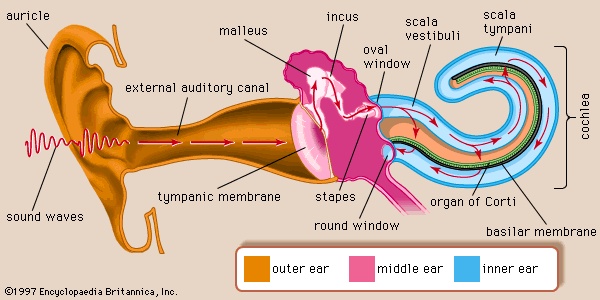 There are a great many varieties of mechanical receptors in animals, but best known are the receptors that mediate touch (touch reception), the variety of hair cell receptors in vertebrates that mediate hearing (the acoustico-lateralis system), and the muscle spindle proprioceptors that monitor the state of muscle contraction. The basic mechanism by which a stimulus is converted to an electrical signal in cells is known as transduction. An example of mechanical transduction, worked out in studies of fruit fly receptors, consists of channels in the membrane that are triggered to open by stretch, which allows cations (cation) to enter the cell.
There are a great many varieties of mechanical receptors in animals, but best known are the receptors that mediate touch (touch reception), the variety of hair cell receptors in vertebrates that mediate hearing (the acoustico-lateralis system), and the muscle spindle proprioceptors that monitor the state of muscle contraction. The basic mechanism by which a stimulus is converted to an electrical signal in cells is known as transduction. An example of mechanical transduction, worked out in studies of fruit fly receptors, consists of channels in the membrane that are triggered to open by stretch, which allows cations (cation) to enter the cell.There are six types of touch receptors (touch reception) in human skin, including free nerve endings, hair follicle receptors, Meissner corpuscles, Merkel endings, Ruffini endings, and Pacinian corpuscles. The first three, free nerve endings, hair follicle receptors, and Meissner corpuscles, respond to superficial light touch; the next two, Merkel endings and Ruffini endings, to touch pressure; and the last one, Pacinian corpuscles, to vibration. Pacinian corpuscles are built in a way that gives them a fast response and quick recovery. They contain a central nerve fibre surrounded by onionlike layers of connective tissue that behave like a shock absorber, transmitting fast events but damping out slow changes. The fibre, which on its own is capable of sustained firing, only responds to rapid events with one or two action potentials (action potential).
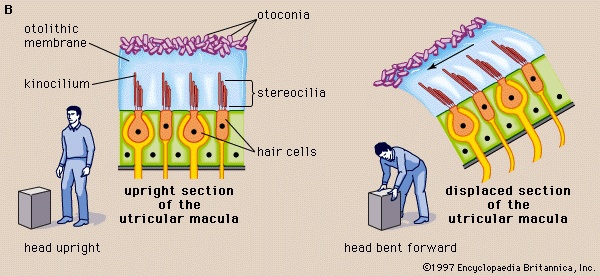 In all vertebrates there is a type of mechanically sensitive cell known as a hair cell. The outer surface of these cells contains an array of tiny hairlike processes, including a kinocilium (not present in mammals), which has a typical internal fibre skeleton, and stereocilia, which do not have fibre skeletons. Stereocilia decrease in size with distance from the kinocilium and are functionally polarized. When the stereocilia are bent toward the kinocilium, the hair cell is excited, and the nerve fibre that contacts the cell fires action potentials. In contrast, bending the hairs away from the kinocilium inhibits firing.
In all vertebrates there is a type of mechanically sensitive cell known as a hair cell. The outer surface of these cells contains an array of tiny hairlike processes, including a kinocilium (not present in mammals), which has a typical internal fibre skeleton, and stereocilia, which do not have fibre skeletons. Stereocilia decrease in size with distance from the kinocilium and are functionally polarized. When the stereocilia are bent toward the kinocilium, the hair cell is excited, and the nerve fibre that contacts the cell fires action potentials. In contrast, bending the hairs away from the kinocilium inhibits firing.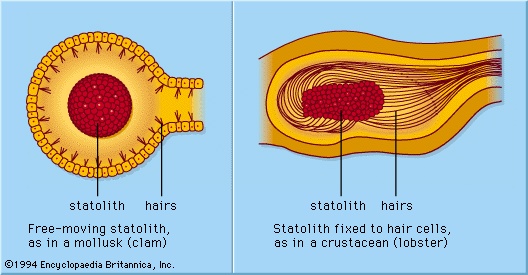 Hair cells have many uses. In fishes (fish) the cells are part of the lateral line system, a series of canals in the skin that are open to the surrounding water and that are used to monitor water currents caused by the fish itself and by other fish. The canals are equipped at intervals with clusters of hair cells, each with a jellylike cap known as a cupula. The cupula is displaced by water movement, thus bending the hairs beneath it, resulting in activity in the nerve. In the inner ear of higher vertebrates there are three variants of this basic design, responsible for detecting the direction of gravity, angular rotation, and sound waves (sound). In the utricle and saccule of the inner ear there are patches of hair cells known as maculae. Within each maculae, the stereocilia are embedded in a gelatinous mass known as the otolithic membrane, which contains small stonelike calcium carbonate particles called otoconia. The otolithic membrane and otoconia bend the hairs in the direction of gravity, providing the animal with a vertical reference direction; similar organs of balance, known as statocysts, are common in invertebrates. Also in the inner ear of vertebrates are the three semicircular canals. Each consists of an almost circular tube, with a bulge at one point containing a cluster of hair cells with a gelatinous cupula attached. When the head rotates, the fluid in the tube lags behind the tissue surrounding it. This displaces the cupula, which causes the stereocilia to bend, providing a signal that is proportional to the rate of head rotation in the plane of the stimulated canal. One of the main functions of the semicircular canals is to drive the vestibulo-ocular reflex, which enables the eyes to counter-rotate and maintain a steady gaze when the head turns.
Hair cells have many uses. In fishes (fish) the cells are part of the lateral line system, a series of canals in the skin that are open to the surrounding water and that are used to monitor water currents caused by the fish itself and by other fish. The canals are equipped at intervals with clusters of hair cells, each with a jellylike cap known as a cupula. The cupula is displaced by water movement, thus bending the hairs beneath it, resulting in activity in the nerve. In the inner ear of higher vertebrates there are three variants of this basic design, responsible for detecting the direction of gravity, angular rotation, and sound waves (sound). In the utricle and saccule of the inner ear there are patches of hair cells known as maculae. Within each maculae, the stereocilia are embedded in a gelatinous mass known as the otolithic membrane, which contains small stonelike calcium carbonate particles called otoconia. The otolithic membrane and otoconia bend the hairs in the direction of gravity, providing the animal with a vertical reference direction; similar organs of balance, known as statocysts, are common in invertebrates. Also in the inner ear of vertebrates are the three semicircular canals. Each consists of an almost circular tube, with a bulge at one point containing a cluster of hair cells with a gelatinous cupula attached. When the head rotates, the fluid in the tube lags behind the tissue surrounding it. This displaces the cupula, which causes the stereocilia to bend, providing a signal that is proportional to the rate of head rotation in the plane of the stimulated canal. One of the main functions of the semicircular canals is to drive the vestibulo-ocular reflex, which enables the eyes to counter-rotate and maintain a steady gaze when the head turns.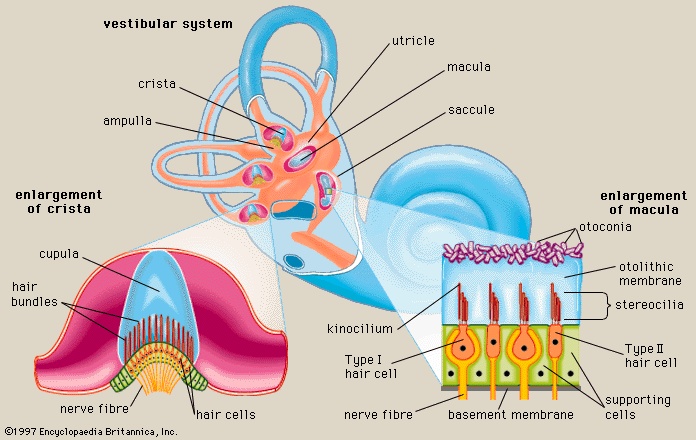 In mammals the ear (ear, human) consists of the outer sound-collecting pinna (auricle); the middle ear, which contains ossicles that function to match the mechanics of sound in air to sound in water; and the inner ear, which contains the cochlea. The cochlea is a complex coiled structure. It consists of a long membrane, known as the basilar membrane, which is tuned in such a way that high tones vibrate the region near the base and low tones vibrate the region near the apex. Sitting on the basilar membrane is the organ of Corti, an array of hair cells with stereocilia that contact a gelatinous membrane called the tectorial membrane. Sound entering the inner ear stimulates different regions of the basilar membrane, depending on sound frequency. Hair cells in the stimulated regions are excited by the resulting shearing action between the stereocilia and the tectorial membrane. There are two kinds of hair cells in the organ of Corti. The inner hair cells are sensory, and the nerves extending from them send acoustic information to the brain. In contrast, the outer hair cells are motile and have a role in amplifying and modifying the movement of the basilar membrane.
In mammals the ear (ear, human) consists of the outer sound-collecting pinna (auricle); the middle ear, which contains ossicles that function to match the mechanics of sound in air to sound in water; and the inner ear, which contains the cochlea. The cochlea is a complex coiled structure. It consists of a long membrane, known as the basilar membrane, which is tuned in such a way that high tones vibrate the region near the base and low tones vibrate the region near the apex. Sitting on the basilar membrane is the organ of Corti, an array of hair cells with stereocilia that contact a gelatinous membrane called the tectorial membrane. Sound entering the inner ear stimulates different regions of the basilar membrane, depending on sound frequency. Hair cells in the stimulated regions are excited by the resulting shearing action between the stereocilia and the tectorial membrane. There are two kinds of hair cells in the organ of Corti. The inner hair cells are sensory, and the nerves extending from them send acoustic information to the brain. In contrast, the outer hair cells are motile and have a role in amplifying and modifying the movement of the basilar membrane.The human ear (ear, human) is sensitive to sounds ranging in frequency from 20 hertz to 20 kilohertz. Below about 1 kilohertz, frequency is signaled by the actual frequency of action potentials in the auditory nerve; above this frequency, however, it is the region of the basilar membrane that vibrates most that specifies frequency. In bats (bat) and in cetaceans (cetacean) (porpoises (porpoise) and whales (whale)) the upper frequency limit is much higher than in humans—more than 100 kilohertz in some cases. These animals use sound to localize objects, both for navigation and for prey capture, and a high frequency is needed to produce a short wavelength, comparable to the size of the prey. Bats hunt by emitting a high-frequency call and listening for the echo ( echolocation). The timing of the echo gives the distance of the target, the shift in frequency gives the relative speed of bat and target, and the frequency spectrum of the returning echo contains information about the size and texture of the target. Typically, bats emit calls at a low rate while cruising, but, if they detect an insect, the rate of emissions speeds up to give a “capture buzz” as the bat closes in on the prey. Many insects have evolved countermeasures to echolocation, including the ability to hear high frequencies, a strategy of power diving to the ground, and, in some cases, the emission of high-frequency clicks to create acoustic confusion.
A special type of mechanical receptor is found in muscles (muscle). These mechanoreceptors are known as muscle spindles and consist of the stretch-sensitive endings of one or more neurons (neuron) attached to a region near the centre of a modified muscle fibre. This fibre has its own innervation, independent of the innervation of the main muscle. The neurons projecting from the muscle spindle respond to lengthening of the muscle. However, by activating the muscle attached to the receptor, the spindle can be stretched or relaxed independently, thereby setting the range over which it will respond to changes in length of the main muscle. This double innervation provides the brain with a very flexible way of activating muscles and of monitoring load-induced stretch.
A number of other minor senses are probably best thought of as mechanical senses. pain often originates from mechanical action, although, where tissue damage results, the stimulus may involve chemical action as well. In some animals, including bees and pigeons (pigeon), there is evidence that a magnetic sense is involved in navigation. In these animals magnetite grains have been found in suitable physiological sensory reception locations. It has been proposed that movement of these grains may act as either a locational or a directional stimulus.
Chemical sense
 The external chemical senses are usually divided into taste, or gustation (for dissolved chemicals that inform about the palatability of food), and smell, or olfaction (for airborne chemicals that inform about events at a distance). The sense of taste in humans is confined to the mouth region, especially the tongue. In contrast, catfish have taste buds covering their whole body surface. There are five accepted Aristotelian sub-modalities of taste—salt, acid, sweet, bitter, and savory (umami)—that are segregated to some extent in different regions of the mouth. Each has a different transduction mechanism. Salt receptors simply respond to the increase in sodium ions entering them. In acid receptors, the H+ ions inactivate potassium channels, resulting in an increase in excitation of the cell. Sweet, bitter, and savory receptors have special proteins in the membrane that detect appropriate molecules. When stimulated, these proteins set off a chain of biochemical events that lead to the production of an action potential. Taste mechanisms require relatively high concentrations; for example, salt and sweet tastes have thresholds of around 0.01 molar. However, bitter tastes, whose function is to prevent organisms from eating toxic substances, have lower thresholds; quinine is detectable in a concentration of only 8 micromolar.
The external chemical senses are usually divided into taste, or gustation (for dissolved chemicals that inform about the palatability of food), and smell, or olfaction (for airborne chemicals that inform about events at a distance). The sense of taste in humans is confined to the mouth region, especially the tongue. In contrast, catfish have taste buds covering their whole body surface. There are five accepted Aristotelian sub-modalities of taste—salt, acid, sweet, bitter, and savory (umami)—that are segregated to some extent in different regions of the mouth. Each has a different transduction mechanism. Salt receptors simply respond to the increase in sodium ions entering them. In acid receptors, the H+ ions inactivate potassium channels, resulting in an increase in excitation of the cell. Sweet, bitter, and savory receptors have special proteins in the membrane that detect appropriate molecules. When stimulated, these proteins set off a chain of biochemical events that lead to the production of an action potential. Taste mechanisms require relatively high concentrations; for example, salt and sweet tastes have thresholds of around 0.01 molar. However, bitter tastes, whose function is to prevent organisms from eating toxic substances, have lower thresholds; quinine is detectable in a concentration of only 8 micromolar.Knowledge of the sense of smell went through a revolution in the 1990s; prior to then there was no consensus as to how many types of “basic” odour existed. In 1991 Linda Buck (Buck, Linda B.) and Richard Axel (Axel, Richard) discovered a family of genes (gene) that were expressed in the nasal epithelium. In humans the genes of working olfactory receptors (olfactory receptor), which signal the presence of specific odorants, number about 350. However, including inactive genes, there are about 1,000 olfactory-type receptor genes, making up roughly 3 percent of the entire human genome. Each odorant receptor (OR) molecule responds to a small family of odorants. For example, a molecule that responds to the 8-carbon compound, octyl aldehyde (octanal), will also respond to 7-, 9-, and 10-carbon aldehydes but not to other compounds (e.g., 8-carbon ketones (ketone)). Calculations indicate that single receptor cells respond to the capture of single molecules, just as photoreceptors respond to single photons (photon). A similar conclusion—that single molecular captures produce single impulses in the receptor axons (axon)—was reached many years earlier in relation to the detection of female pheromone by the antennae of male silk moths (moth).
The human nose is relatively insensitive; for example, the human threshold for butyric acid is nearly a million times higher than it is for a dog. This insensitivity, however, is not due to the existence of different receptors in humans and dogs but is the result of an evolutionary reduction in the size of the nasal epithelium in humans that causes inhaled air to bypass the epithelium. In most land vertebrates there is a second olfactory system, the vomeronasal organ (Jacobson organ (Jacobson's organ)), situated in either the roof of the mouth or the floor of the nose. Its function is the detection of pheromones and other biologically significant chemicals; however, the degree of function of this organ in humans remains a matter of debate.
Electric (electricity) sense
Two families of fish, the mormyrids (mormyrid) of Africa and the gymnotids of South America, have independently developed a unique sense for the detection of objects in their surroundings and for communication. These fish usually inhabit murky rivers, such as the Amazon (Amazon River) or the Nile (Nile River), where vision is impossible. They have an organ in the tail, derived from nerve or muscle, that sends weak electrical discharges into the surrounding water. They also have an array of receptors, derived from lateral line organs and situated over the front part of the body, that detect the electric field produced by the tail organs. Objects in the surroundings of the fish distort this field, and the changes are detected and interpreted in terms of the locations and electrical properties of the objects. This makes navigation possible over a range of a few metres. The sense is also used in both aggressive and sexual communication. Other fish such as sharks (shark) have electroreceptors but no electric organs, and they use electroreception in a passive sense to detect the electric fields that result from the neuromuscular activity of buried prey.
Additional Reading
Useful introductory accounts of sensory function include Fred Delcomyn, Foundations of Neurobiology (1997); and Robert F. Schmidt and Helmut Altner (eds.), Fundamentals of Sensory Physiology, 3rd ed. (1986). Coverage of sensory physiology, with a bias toward the human senses, is provided by C.U.M. Smith, Biology of Sensory Systems, 2nd ed. (2008). An interesting account of the senses in terms of information gathering is given in David B. Dusenbury, Sensory Ecology (1992). A six-volume reference, with chapters by different authors, that provides extensive information on various facets of sensory neuroscience is A.I. Basbaum et al., The Senses: A Comprehensive Reference (2008).
- experimental psychology
- expert system
- explication de texte
- explicit
- exploration
- Explorer
- explosion seismology
- explosive
- exponential function
- Export-Import Bank of Japan
- Export-Import Bank of the United States
- ex post facto law
- exposure meter
- Expressionism
- expressway
- exsolution
- extended family
- extensive agriculture
- extensor muscle
- extenuating circumstance
- extermination camp
- Exterminator
- external auditory canal
- External dose due to natural radioactivity in soil or rock
- extinction